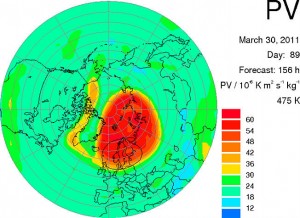“Record Ozone Loss Over North Pole” Written by: Eurasia Review
Written by: Eurasia Review
April 6, 2011
In the past few weeks, exceptional weather conditions have led to unprecedented ozone depletion over the Arctic. Ground and satellite observations by researchers at the Laboratoire Atmosphères, Milieux, Observations Spatiales (CNRS/UVSQ/UPMC) as well as French models show that ozone loss reached around 40% at the end of March.
The phenomenon was caused by an extremely cold and persistent stratospheric winter, resulting in significant ozone destruction, which, unusually, continued into spring.
Europe ozone forecast for March 30. Source: European Centre for Medium-Range Weather Forecasts
Europe ozone forecast for March 30. Source: European Centre for Medium-Range Weather Forecasts
The ozone layer acts like a shield that protects life on Earth from harmful ultraviolet solar radiation. Ozone concentrations and total content have been continually monitored since the signing in 1987 of an international treaty, the Montreal Protocol, which regulates the production of halocarbons.
These are chemical compounds that contain chlorine and bromine and cause the destruction of ozone in the stratosphere (the part of the atmosphere that extends from an altitude of around 10 to 50 km and where the concentration of ozone is at its highest). Since halocarbons remain in the atmosphere for tens of years, it will be several decades before their concentration falls back to its pre-1980 level.
Destruction of stratospheric ozone takes place in the polar regions when temperatures drop below -80°C. At these temperatures, clouds form in the lower stratosphere. Chemical reactions inside them transform compounds derived from halocarbons—which are harmless to ozone—into active compounds. These processes lead to the rapid destruction of ozone when sunlight returns over the pole.
In the Antarctic, the ‘ozone hole’ (which results from the destruction of over half the total ozone content in spring) is a recurring phenomenon due to the extremely low temperatures in the stratosphere every winter. In the Arctic, on the other hand, wintertime temperatures are warmer on average than at the South Pole, and weather conditions vary considerably from one year to the next. This explains why ozone depletion can be less significant there.
This year, the record ozone loss observed was caused by extreme weather.
Researchers at the Laboratoire atmosphère, milieux, observations spatiales (CNRS/UVSQ/UPMC) have access to a battery of measurement stations and infrared and UV-visible monitoring systems that monitor ozone on a daily basis all around the planet.
These observations are part of the World Meteorological Organization and United Nations Environment Program’s Global Ozone Observing System.This winter, observations as well as simulations carried out by these teams using the Reprobus(4) model revealed an extremely significant drop in total ozone content over a wide area. The persistence and extent of this loss, which has lasted for several weeks and reached 40% et the end of March, are absolutely unprecedented.
French and European teams are currently working in the field north of the Arctic Circle (Kiruna, Sweden) to take detailed observations of these exceptional conditions using instruments on board stratospheric balloons operated by CNES. And instruments at the Haute Provence observation station (sounding balloons and LIDAR system) will be used to detect the impact of this event on lower latitudes when springtime warming of the polar stratosphere pushes ozone-depleted air masses towards these regions.
Without the Montreal Protocol, this year’s ozone destruction would have been considerably worse. As long as chlorine and bromine concentrations in the stratosphere remain high, significant ozone depletion similar to that observed this year may happen again during exceptionally cold Arctic winters.
According to the latest international report assessing the state of the ozone layer, ozone should recover its pre-1980 levels around 2045-60 over the South Pole, and probably one or two decades earlier over the North Pole.
About the author:
Written by Eurasia Review, April 6, 2011, “Record Ozone Loss Over North Pole.” http://www.eurasiareview.com/record-ozone-loss-over-north-pole-06042011/
Copyright © 2011 Eurasia Review. Deluxe Indomagz by Eurasia Review
Accessed 1 September 2011.
| 日焼け止め関連商品 |
|---|
 日焼け止め SPF50 PA+++/COOL/ペパーミント 日焼け止め SPF50 PA+++/COOL/ペパーミント【特徴1:Cool】 塗るとスーッと清涼感 【特徴2:肌ケア】 日焼けの炎症を抑える成分と保湿を保つための成分、贅沢配合 【特徴3:微香】 汗の匂いを緩和するためにペパーミントのほのかな香り |


